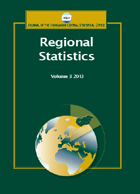Examining the Factors of Endogenous Development
in Hungarian Rural Areas by Means of PLS Path Analysis
Examining the Factors of Endogenous Development
in Hungarian Rural Areas by Means of PLS Path Analysis
Author(s): Péter Kovács, Bodnár GáborSubject(s): Social Sciences, Economy, Geography, Regional studies
Published by: Központi Statisztikai Hivatal
Keywords: PLS path analysis; endogenous development; forms of capital; dependencies; rural areas
Summary/Abstract: The study analyses the development of Hungarian rural sub-regions. After the delimiting of the countryside, we focus on the academic literature of endogenous regional development. There are many approaches to the theory and, thus, there are differences and similarities between the key factors of the theory. We synthesize these forms of capital to create a conceptual framework that can serve as a basis for quantitative analyses. We propose our own measuring system and a model to reveal the relations among endogenous capital factors in the framework of a descriptive analysis, relying on the theory of endogenous development. Furthermore, we propose a model that explains development, and includes latent variables symbolising the forms of capital. We then examine the model using a partial least squares path analysis. The results show that the various forms of capital thought to be relevant in the literature are not all included in the regression model. This shows and helps us to understand the connections between forms of capital, although the model is only valid in a rural context. Furthermore, we find that the relations between the forms of capital vary considerably over time.
Journal: Regional Statistics
- Issue Year: 7/2017
- Issue No: 01
- Page Range: 090-114
- Page Count: 25
- Language: English

